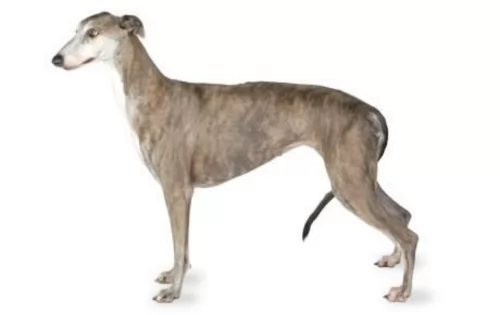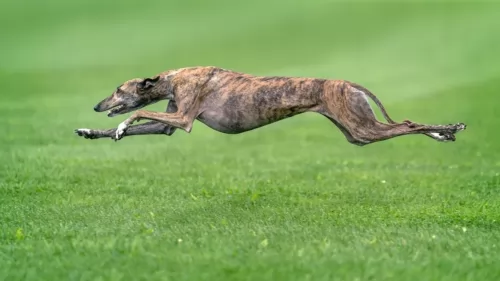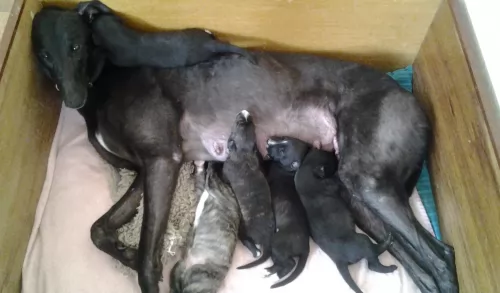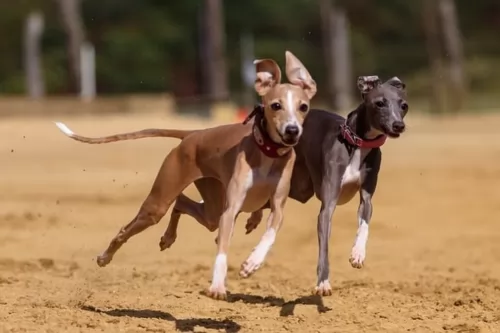 Petzlover
PetzloverGreyhound is originated from United Kingdom but Serbian Mountain Hound is originated from Serbia. Greyhound may grow 26 cm / 11 inches higher than Serbian Mountain Hound. Greyhound may weigh 18 kg / 40 pounds more than Serbian Mountain Hound. Both Greyhound and Serbian Mountain Hound has almost same life span. Greyhound may have more litter size than Serbian Mountain Hound. Both Greyhound and Serbian Mountain Hound requires Low Maintenance.
 The Greyhound belongs to a group of dogs known as sighthounds. This is an ancient sighthound breed dating back a few thousands years.
The Greyhound belongs to a group of dogs known as sighthounds. This is an ancient sighthound breed dating back a few thousands years.
The dog has been bred for racing but today is also a popular pet. They’ve also been used for hunting too because of their keen eyesight and sense of smell.
In the United States there are Greyhounds registered with the American Kennel Club as well as those registered with the National Greyhound Association.
Known as the Srpski Planinski Gonic dog and coming from Yugoslavia, the Serbian Mountain Hound is one of two modern hounds that was once known as the Yugoslavian Mountain Hound or Jugoslovenski Planinski Gonic.
There isn't much information on the origins of the dogs. These two dogs are considered similar breeds, only varying in region. Its a hunting dog thought to have descended from Asian search dogs.
 The Greyhound is a tall, muscled, long-legged, slender dog with a flexible spine, a deep chest and exceptional eye sight.
The Greyhound is a tall, muscled, long-legged, slender dog with a flexible spine, a deep chest and exceptional eye sight.
The Males are usually about 71 to 76 cm in height with the females being slightly smaller. The dogs weigh in the region of 27 to 40 kg. The coat of the dog is short and smooth and is found in an assortment of colors, from fawn to white, tan, black and brindle.As far as grooming goes, he is looked upon as a low maintenance breed.
He has a long narrow muzzle, semi-erect/semi-floppy short ears and a long slender tail.
Sometimes referred to as being hypoallergenic, you need to allow your Greyhound indoors as the dog doesn't have an undercoat. He is therefore more susceptible to extreme temperatures. The face is long, narrow and pointed, the ears short and half-erect-half-floppy with a long, thin, whip-like tail.
Intelligent and gentle, the Greyhound is described by those who have owned them as wonderful pet. They are somewhat aloof around strangers but love their own human family. This is a non-aggressive, gentle, docile, calm dog. They are loving and get on well with their entire family, whether human beings or pets.
They’re sensitive dogs who appreciate quiet, calm environments. They may be quiet, but they are still social, loving the company of their family. They’re not great barkers and because they are non-aggressive, they don’t make wonderful guard dogs.
The Serbian Mountain Hound is about 46 to 50cm in height and weighs around 18 to 22 kilograms. This Yugoslavian hound breed has been used in Serbia as a hunting dog and they are thought to be rare outside of Serbia.
The coat of the newer Mountain Hound is fairly short and thick and mainly black with some tan marks around the paws and muzzle. The dog has floppy ears and a long tail.
This is a hardy scent hound that is confident and bold. They are used to hunting on rough terrain in the Balkan region. They are independent dogs and training and socialization will refine them, making the dog obedient and well mannered.
When he isn’t outdoors, he becomes a good-natured, gentle amiable dog that is good with children in the home.
 The Greyhound, forgetting about the racing part, makes a superb pet too. He won't do well in a household where there are screaming, noisy children and adults as he wants a quiet home to live in.
The Greyhound, forgetting about the racing part, makes a superb pet too. He won't do well in a household where there are screaming, noisy children and adults as he wants a quiet home to live in.
He can get on well with kind, gentle, respectful children as well as with pets in the home. Just like any dog, he will also need training and socialization as this can build up his confidence and then he knows how to please his owners and what they expect.
The Greyhound will require a gentle, fair, kind owner who understands his need for peace and quiet, and then he becomes a most wonderful devoted, loyal and loving pet.
The Serbian Mountain Hound is such a social, happy, friendly kind of dog that he makes a wonderful family pet.
He learns well, he likes to please, he gets on well with children and dogs in the home, he is independent and not a noisy barker. He is also fairly low maintenance.
Take good care of him and you’re guaranteed to have a wonderful pet and companion.
 Greyhounds are a wonderfully healthy dog breed and with good care can reach 14 years of age. They aren't prone to many genetic illnesses and unlike so many other dog breeds, this is one dog that doesn't battle with hip dysplasia – in fact it is almost unknown among this tall, slim dog breed.
Greyhounds are a wonderfully healthy dog breed and with good care can reach 14 years of age. They aren't prone to many genetic illnesses and unlike so many other dog breeds, this is one dog that doesn't battle with hip dysplasia – in fact it is almost unknown among this tall, slim dog breed.
The Greyhound does however, have a deep chest and this is what makes him vulnerable to bloat or gastric torsion. You have to take action quickly if you detect bloat – the stomach swells up – as this is a life-threatening condition that can occur quickly when air is trapped in the stomach. The stomach can become twisted.
Make sure your Greyhound doesn't gobble his food too quickly and preferably give him smaller meals as opposed to one or two large bowls of food.
Nobody wants their dog to be sick and lethargic, after all they are our best friend’s. Some ways to check the status of your dog’s health -
Check his breath, as a bad breath, just like as with a human being, can be a sign of illness. It can also be indicative of dental problems, digestive or kidney problems.
Spread his fur and check that the skin is a healthy color – pink, grey or black. Make sure there is no crusting or itching with red, inflamed areas. Make sure the coat is thick and lustrous – not falling out and thinning.
Make sure the nails aren’t split, flaking and broken and that the paws aren’t cut so that the dog is constantly licking them.
Every dog drinks a lot of water after hectic exercise, but if your dog suddenly becomes very thirsty more than usual, it could be indicating a medical problem, and you will need to discuss it with your vet.
 Your Greyhound’s breeder will be the best guide for the type of- and the amount of dog food your hound will need. Of course, a growing puppy has different nutritional needs from a mature or senior Greyhound.
Your Greyhound’s breeder will be the best guide for the type of- and the amount of dog food your hound will need. Of course, a growing puppy has different nutritional needs from a mature or senior Greyhound.
Growing puppies and young dogs use a lot of energy so they will require a diet rich in protein. According to Greyhound experts, an adult Greyhound dog will need an average daily caloric intake of 1740 calories.
Older dogs and those that have been spayed or neutered will need less. Apart from the very best quality kibble, your Greyhound will most certainly require raw meat from time to time. You can also give him some cooked chicken, vegetables and brown rice. He should have access to a constant supply of fresh, cool water.
The Greyhound's coat is smooth and short and he sheds very little so he will only need a gentle brush-down once or twice a week.
Having a relaxed lifestyle is what your Greyhound will love. He is a dog that needs to spend time indoors. When outdoors, whether you live in the city or the country, he will need daily walks and a run in the park regularly.
Just because he is a sprinter, it isn't wise to take him with you with cycling or jogging as he is geared for a short burst of speed as opposed to a long run.